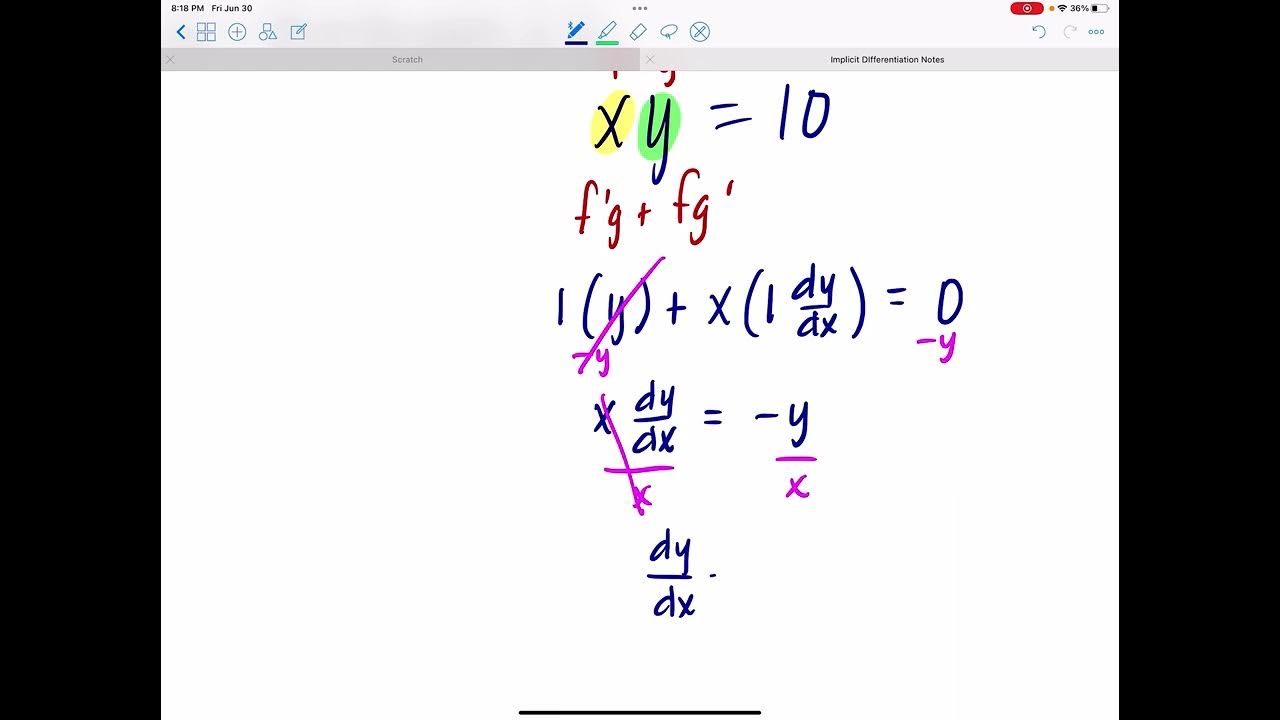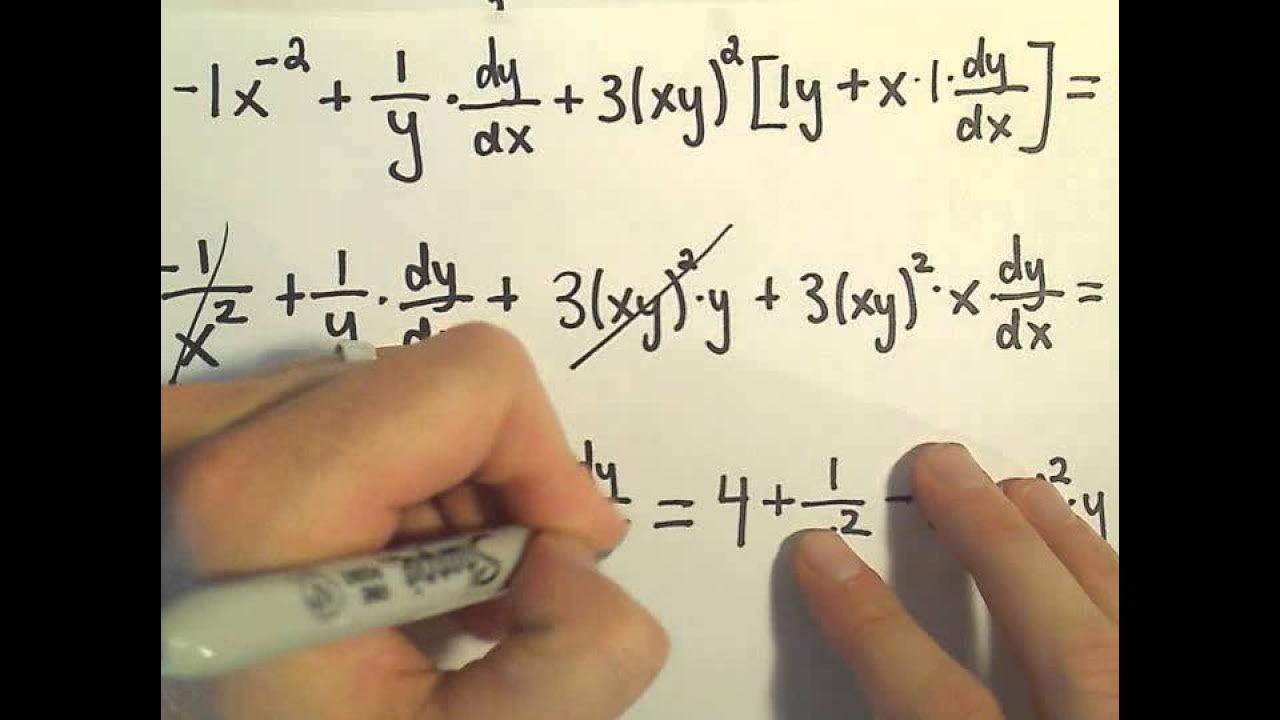Implicit Differentiation
TLDRThis video teaches the concept and techniques of implicit differentiation, which allows taking the derivative of a function with multiple variables without needing to solve it explicitly for one variable first. It steps through examples of applying implicit differentiation to various equations, using product and chain rules appropriately when differentiating with respect to x and treating y as a function of x. Key points covered are remembering to use chain rule when taking the derivative of y, factoring out y' terms, and ultimately solving the differentiated equation for the desired dy/dx. Several examples showcase the algorithm, highlighting that with practice, this technique becomes straightforward.
Takeaways
- 😀 Implicit differentiation allows us to take the derivative of a function without having to solve for one variable in terms of another first.
- 👍 To use implicit differentiation, take the derivative of both sides of the equation with respect to the variable you want the derivative for.
- 💡 Use the normal differentiation rules like the product rule, chain rule and constant rule when taking the derivatives.
- 📝 Treat the other variables like functions of the one you are differentiating with respect to and use the chain rule.
- 🧮 Rearrange the terms to isolate the derivative you want and solve for it.
- 😎 Implicit differentiation makes taking derivatives of some complex equations much easier.
- 🤓 The key is to remember to treat the other variables like functions and use the chain rule when differentiating them.
- 📚 Implicit differentiation uses all the normal differentiation rules we already know.
- 👌 With practice, implicit differentiation becomes easy to apply.
- 🎓 Implicit differentiation is a handy technique for finding derivatives without having to do a lot of pre-work rearranging the equation.
Q & A
What is implicit differentiation and when is it used?
-Implicit differentiation is a technique used to take the derivative of a function where one variable is not explicitly expressed in terms of the other. It is used when solving for one variable in terms of the other would be difficult or impossible.
What is the first step when applying implicit differentiation?
-The first step is to take the derivative of both sides of the equation with respect to the variable you want to differentiate with respect to, usually x. This is represented by dx in the numerator.
Why do we treat y as a function of x when differentiating implicitly?
-When differentiating implicitly, we are treating y as a function of x, even if it is not explicitly written that way. This allows us to take derivatives involving y using the chain rule, since y depends on x.
What rule do we use when differentiating a term that is a product?
-For a term that is a product, such as x^2*y, we must use the product rule to differentiate. This will result in multiple terms involving the derivatives of each factor.
What rule do we use when differentiating a composite function?
-For a composite function, such as y^2, we use the chain rule. This involves taking the derivative of the outer function and multiplying by the derivative of the inner function.
Why do we rearrange the terms so that y' is on one side?
-We group the y' terms on one side so that we can factor it out and eventually divide both sides by the other terms. This allows us to solve for y', which is the goal.
What trigonometric identities can help simplify implicit differentiation?
-Using trigonometric identities like sine/cosine = tangent can help simplify the final derivative expression by substituting in tangents.
What is the intuition behind the chain rule when applied to implicit differentiation?
-The chain rule with implicit differentiation makes sense if you imagine y representing a function with x terms inside parentheses. Taking the derivative using the chain rule reflects differentiating that nested structure.
What is the difference between explicit and implicit differentiation?
-Explicit differentiation directly differentiates an equation where y is expressed explicitly as a function of x. Implicit differentiation can handle equations where y depends on x but is not written explicitly that way.
What is the main challenge when first learning implicit differentiation?
-The main challenge is recognizing that y represents a function of x and using the chain rule appropriately when differentiating terms involving y. Once you understand that, implicit differentiation follows logically.
Outlines
📝 Implicit Differentiation Explained and Demonstrated
This paragraph introduces implicit differentiation as a technique to find the derivative when one variable is not explicitly expressed in terms of the other. It provides examples showing how to apply the chain rule and product rule to differentiate both sides of an equation with respect to x and solve for the derivative dy/dx.
😀 More Challenging Implicit Differentiation Examples
This paragraph provides two more examples applying implicit differentiation to find dy/dx when given equations relating x and y. The steps of differentiating both sides, isolating dy/dx terms, and solving for dy/dx are demonstrated.
🧠 Understanding the Core Concepts Behind Implicit Differentiation
This concluding paragraph reiterates that implicit differentiation relies on applying differentiation rules like the chain rule when treating y as a function of x. It emphasizes getting comfortable with the core concepts to confidently apply implicit differentiation.
Mindmap
Keywords
💡implicit differentiation
💡derivative
💡chain rule
💡y prime
💡product rule
💡function
💡solve
💡algorithm
💡exponent
💡parentheses
Highlights
First highlight text
Second highlight text
Transcripts
5.0 / 5 (0 votes)
Thanks for rating:





